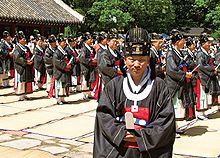Lee (Korean surname)
This article's tone or style may not reflect the encyclopedic tone used on Wikipedia. (October 2020) |
 The one hanja for Yi | |
| Pronunciation | [iː] or [riː] |
|---|---|
| Language(s) | Korean |
| Origin | |
| Language(s) | Chinese |
| Word/name | Korean peninsula |
| Meaning |
|
| Other names | |
| Variant form(s) | Ee, I, Yi, Ri, Rhee, Rhie, Reeh |
| See also | Li, Lý |
| Yi (Ri) | |
| Hangul | 이 (리) |
|---|---|
| Hanja | |
| Revised Romanization | Ee, Lee, Li, Yi, I, Ri |
| McCune–Reischauer | Ee, Lee, Li, Yi, I, Ri Note: "李" is officially romanized as I in South Korea and Ri in North Korea. |

Lee, I, or Yi (이) is the second-most-common surname in Korea, behind Kim (Gim). Historically, 李 was officially written as Ni (니) [2] in Korea. The spelling officially changed to I (이) in 1933 when the initial sound rule (두음법칙) was established. In North Korea, it is romanized as Ri (리) because there is no distinction between the alveolar liquids /l/ and /r/ in modern Korean. As of the South Korean census of 2015, there were 7,306,828 people by this name in South Korea or 14.7% of the population.[3]
Latin-alphabet spelling[]
Though the official Revised Romanization spelling of this surname is I, South Korea's National Institute of the Korean Language noted in 2001 that one-letter surnames were quite rare in English and other foreign languages and could cause difficulties when traveling abroad. However, the NIKL still hoped to promote systemic transcriptions for use in passports, and thus recommended that people who bore this surname should spell it Yi in the Roman alphabet.[4][5]
However, the majority of South Koreans with this surname continue to spell it as Lee, because conditions for changing passport name is strict. [6] In a study based on 2007 application data for South Korean passports, it was found that 98.5% of people with this surname spelled it in Latin letters as Lee in their passports, while only 1.0% spelled it Yi.[7]
A few people with this surname historically spelled it Ye, as in Ye Wanyong of the Korean Empire. Rhee has also been used, as in Syngman Rhee and Simon Hang-bock Rhee.
Clans[]
This section's tone or style may not reflect the encyclopedic tone used on Wikipedia. (November 2014) |

As with all Korean family names, the holders of the Yi surname are divided into different patrilineal clans, or lineages, known in Korean as bon-gwan, based on their ancestral seat. Most such clans trace their lineage back to a specific founder, and are generally not related to one another. This system was at its height under the yangban aristocracy of the Joseon Dynasty, but it remains in use today. There are approximately 241 such clans claimed by South Koreans. Most people with surname Yi (李) in Korea belong to either the Jeonju or Gyeongju clans. Also surnames Yi (異) and Yi (伊) each have a different clans.
Imperial household of the Jeonju clan[]
This section needs additional citations for verification. (November 2014) |

This clan has roots in the Joseon Dynasty. The founder of this clan was Yi Han, a native of Baekje who later married a Silla princess and became a high official of Silla. His 22nd-generation descendant, Taejo of Joseon, went on to found the Joseon Dynasty. The House of Yi ruled Joseon for 518 years between 1392 and 1910 and established many of the cultural, artistic and linguistic foundations for modern-day Korea.
During its reign, the House of Yi consolidated its effective rule over the territory of current Korea, encouraged the entrenchment of Korean Confucian ideals and doctrines in Korean society, imported and adapted Chinese culture, and promoted classical Korean culture, trade, science, literature, and technology.
As of 2005, the pretender to the Joseon throne is Prince Yi Seok.[8] Members of the different branches of Jeonju Yi survived until the formation of the current Republic of Korea. Many families claim membership in the House of Yi, but few actually descend from the lineage. King Sejong, King Taejo, and others are from this lineage. South Korea's first president Syngman Rhee claims descent from the lineage.
Gyeongju clan[]
The founder of the Gyeongju clan was Yi Alpyeong (李謁平), one of the village headmen who chose Bak Hyeokgeose as the first king of Silla. According to the Samguk Sagi, the Yi name was officially bestowed on the family by King Yuri around 9 CE.
Notable present-day members of this clan include Lee Byung-chull, the founder of Samsung Group; Lee Kun-hee, the former Samsung CEO; and Lee Myung-bak, former president of South Korea.[9]
The Gyeongju Yi clan, according to the 2000 South Korean census, numbered over 1.4 million individuals, making it the most numerous of the clans that bear the surname Yi.[10]
Pyeongchang clan[]
The founder of the Pyeongchang clan was Yi Gwang, an official and military commander of the joseon dynasty. Yi Seung-hun, who was the first person that brought Catholicism to Korea, was a member of this clan. the clan was founded somewhere between 1580 and 1607.the clan where nobles. of the highest rank: Yangban.
Deoksu clan[]
The founder of this clan was Yi Dongsu, an official of the Goryeo period. This was a prominent yangban clan during the Joseon Dynasty, producing figures including the admiral Yi Sun-sin and the philosopher Yi I. The clan seat, Deoksu, corresponds to Deoksu-hyeon, an old division of what is now in Kaesong city, North Korea.
Jinbo clan[]
The Jinbo Yi clan was known for the famous Joseon scholar Yi Hwang, who founded the Yeongnam school and started a private Confucian academy. He also became one of the 18 Sages of Korea (동방 18현) and was honored as a Munmyo Bae-hyang (문묘배향).[11] The progenitor of this clan was Yi Seok of the Goryeo Dynasty.
Yong-in clan[]
The founder of the Yongin clan was Yi Gil-gwon, who helped to found Goryeo. Includes Sin Saimdang who was a Korean artist, writer, calligraphist, and poet. She is the first woman to be portrayed on a 500000 won bank note.
Yeoju clan[]
Prominent members of this clan include the Joseon-dynasty philosopher Yi Ik.
Danyang clan[]
The founder of this clan was Yi Bae-hwan. A prominent member of this clan was Yi Yun-yong, who was acting Prime Minister of South Korea in 1952.
Yangsan clan[]
The founder of this clan was Yi Man-yeong, an internal minister in Korea following the fall of the Goryeo Dynasty. He died of strangulation near an isolated mountain.
Suan clan[]
The founder of this clan was Yi Gyeon-ung, who helped found the Goryeo Dynasty.
Seongju clan[]
The founder of this clan was Yi Sun-yu, a prominent official of late Silla. His 12th-generation descendant Yi Jang-gyeong was also a prominent official of the Goryeo Dynasty. Eight generations of Jang Kyung's descendants yielded 75 civil examination qualifiers. As of a 2000 census conducted by the ROK, 186,188 Koreans of the Seongjoo Yi clan live in South Korea.
Hongju clan[]
The founder of the Hongju Yi clan was , a member of the King's inner circle during the late Goryeo Dynasty. The clan's ancestral seat was bestowed when his 9th generation descendant, Yi Gi-jong, was titled. Hongyang/Hongju is located in present-day Hongseong, South Chungcheong Province. Especially during the late Goryeo and early Joseon Dynasties, the Hongju Yi clan produced many outstanding and influential people, including , , , and Yi Jong-jang.
Yeonan clan[]
The Yeonan Yi clan[12] were aristocrats during the Joseon Dynasty. Several members were prime ministers. The clan also had a high number of Chief Scholars during that period. The progenitor was Yi Mu, who was from Tang China.
Hansan clan[]
It is based in Hansan-myeon, Seocheon-gun, Chungcheongnam-do. There are two different strains (Hojanggong family and Kwonjigong family). The founder of this clan is Yi Yoonkyung. One member of the clan is Mogeun Yi Saek, a Confucian scholar of Goryeo. He founded an academy that educated founders of Joseon Dynasty. Hansan Yi clan produced many scholars also in Joseon dynasty such as Yi Sanhae. Modern figures belonging to Han San Yi clan include , an independence activist of the Korean Empire under Japanese rule.
People with the surname[]
See also[]
- List of common Korean surnames
References[]
- ^ 리(Ri) in North Korea and 이(I) in South Korea. However, 이(I) in South Korea use 리(Lee) as their official English surname.
- ^ For example, F. C. Ridel's Grammaire Coréenne published in 1881. https://imgur.com/oSxewU0 Also, Independence Newspaper(獨立新聞), the nation's first Korean-only newspaper in 1896. https://imgur.com/7bruwF7
- ^ "2015년 인구주택총조사 전수집계결과 보도자료" [Results of the 2015 Census of Population and Housing survey]. Korean Statistical Information Service. Retrieved 28 May 2019.
- ^ 성씨 로마자 표기 방안: 마련을 위한 토론회 [Plan for romanisation of surnames: a preparatory discussion]. National Institute of the Korean Language. 25 June 2009. p. 8. Retrieved 22 October 2015.
- ^ Kim, Yun-gu (2009-06-25). "성씨 로마자 표기 朴 'Bak' 李 'Yi' 제시" [Rules of romanization for surnames: 'Bak' for 朴, 'Yi' for 李 proposed]. Yonhap News. Retrieved 2015-03-07.
- ^ "로마자성명 표기 변경 허용 요건". Ministry of Foreign Affairs. 2007. Retrieved 2019-05-17.
- ^ NIKL 2009, p. 59
- ^ "A Prince Nestled Once More in Korea's Embrace", The New York Times, May 20, 2006.
- ^ Han Jeong-gon (한정곤) (2004-07-29) <재벌가 얽히고 설킨 혼맥 24탄> 삼성그룹 Archived 2009-10-21 at the Wayback Machine Ilyo Siisa, Vol. 445
- ^ Surname Info. "I." (Korean language site - "이" is spelled phonetically as "I") The specific reference is at the very bottom of the main entry, under the section "[인구 (人口) - 경주, 월성]," which gives both the 1985 census population of the clan at 1,217,279 individuals, and the 2000 population at 1,424,866 individuals. http://www.surname.info/i/gyeong_ju.html
- ^ Joseon Annals, September 15, 1604. No. 4
- ^ Joseon Annals, March 21, 1790. No. 3
- Korean-language surnames